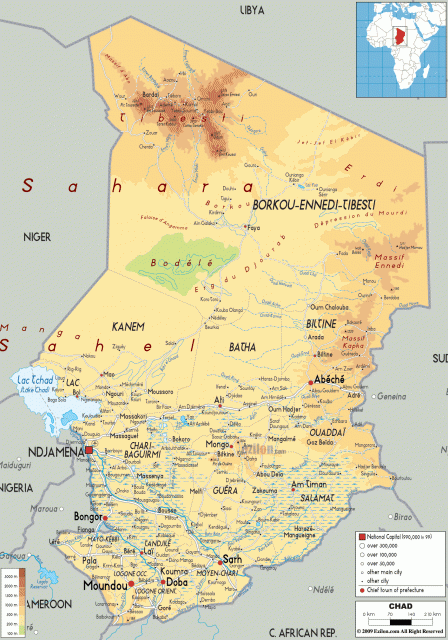Republic of Chad
POPULATION: 13.21 million (2014)
AREA: 495,792 sq. mi. (1,284,000 sq. km)
LANGUAGES: French, Arabic (official); Sara, Sango, others
NATIONAL CURRENCY: CFA franc
PRINCIPAL RELIGIONS: Muslim 50%, Traditional 25%, Christian 25%
CITIES: N'Djamena (capital), 826,000 (1999 est.); Sarh (Fort Archambeault), Moundou, Bongor, Doba, Lai, Abeche, Koumra
ANNUAL RAINFALL: Variable, from 35–47 in. (900–1200 mm) in subtropical zone to 18–20 in. (200–500 mm) in Saharan zone
ECONOMY: GDP $13.92 billion (2014)
PRINCIPAL PRODUCTS AND EXPORTS:
- Agricultural: cotton, cattle, sorghum, millet, peanuts, rice, cassava, sugarcane, livestock, fish
- Manufacturing: livestock products and meatpacking, beer brewing, textiles, tobacco processing
- Mining: petroleum, uranium, natron, kaolin
GOVERNMENT: Independence from France, 1960. President elected by universal suffrage. Governing bodies: 57-member Conseil Superieur de la Transition, elected by a national conference, and Council of State, appointed by president.
HEADS OF STATE SINCE INDEPENDENCE:
- 1960–1975 President FranCois-Ngarta Tombalbaye
- 1975–1979 General Felix Malloum, chairman of Supreme Military Council
- 1979– President Lol Mahamat Chaoua
- 1979–1982 President Goukouni Oueddei
- 1982–1990 President Hissene Habre
- 1990– President Lieutenant General Idriss Deby
ARMED FORCES: 25,400 (1998 est.)
EDUCATION: Compulsory for ages 8–14; literacy rate 48%

Chad is a large, landlocked country that lies south of LIBYA. Its history since independence has been marked by civil war, which has left Chad one of the poorest countries in the world.
The Land and the People
Chad lies on a vast plain that is divided into two very different regions. The northern part of the country is very dry, and desert dominates the far north. Most of the inhabitants are nomadic Muslim groups such as the FULANI, who raise livestock and camels.
The south consists of relatively well-watered savanna and contains the country's main rivers, the Shari and Logone. About half of the people of Chad live in the south, which also has most of the country's urban centers. The main livelihood of southerners is agriculture. Many of the people have converted to Christianity, but large numbers still hold on to traditional religious beliefs and practices.
History and Government
Rock paintings and other archaeological evidence indicate that northern Chad was settled as early as 5000 to 2000 B.C. The southern portion of the country was not occupied until about 500 B.C. BERBER peoples moved into northern Chad around the A.D. 700S, pushed southward by the spread of the SAHARA DESERT into borderland regions. A series of kingdoms arose in central Chad between 1000 and 1600. They gained power and wealth by conquering peoples of the region and demanding tribute and by controlling the southern part of the trade route across the Sahara. Much of their wealth came from capturing people from the south and selling them as slaves to Arab peoples in the north.
The French colonized Chad in 1900, combining the northern and southern sections for the first time. Under the French the south received far more assistance than the north. Some southerners held positions as teachers and businessmen, and some entered government service. After World War II, these groups played a major role in organizing the movement for independence. Chad gained its independence from France in 1960.
The first president of the new country, Francois-Ngarta TOMBALBAYE, outlawed all political parties except his own and installed an overwhelming number of southerners in the government. This led to protests and uprisings in the central and northern parts of Chad, where rebel groups gained control in the early 1970s. A military coup in 1975 was followed by a long civil war, and during this time warlords ran much of the country.
The authority of the central government was finally reestablished in 1982, but its harsh rule led to renewed fighting. In 1990 troops under the command of General Idriss Deby defeated President Hissene Habre, and Deby became president. In 1996 the country held the first multiparty presidential elections. Deby won. However, Chad continues to be plagued by political violence and low-level guerrilla warfare. Under Chad's constitution the people elect the president, while a national conference chooses the prime minister. The conference also chooses the national assembly, which oversees the government and has the power to dismiss the prime minister.
Economy
Chad has few natural resources, and many of these have been devastated by continual war. Most Chadians are engaged in agriculture, with cotton accounting for about 60 percent of the country's export earnings. However, Chad's agriculture does not always produce enough to feed the people, and the country must import food in years when rainfall is not adequate. Chad has very little industrial development and relies heavily on foreign assistance to meet its budget. The discovery of oil in the late 1990s may help relieve some of the country's economic problems.